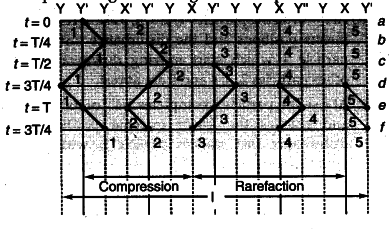A longitudinal wave motion is that wave motion in which indivdual particles of the medium execute simple harmonic motion about their mean position along the same direction along which the wave is propagated.
Example : Vibrations of air column of organ pipes are longitudinal.
Propagation of longitudinal waves.
Let us consider a series of 5 equally spaced particles 1, 2, 3, 4, 5 in one horizontal level. When these particles execute simple harmonic motion of equal amplitudes and equal time period about their mean position along the straight line in which they are placed, we can show that a longitudinal wave travels to the right.
In the given figure, solid lines represent the mean positions dotted lines around the solid lines represent the extreme positions of the particles while vibrating xy = x\f is the amplitude of vibration.
Let x is the time period of vibration of each particle, the disturbance is handed on from one particle to . the adjoining particle in T/4 sec.
(i) At f = 0, all the particles 1,2, 3,4,5 are at rest their
mean positions and the disturbance just reaches particle 1.
(ii) At f = T/4, particle 1 completes 1/4 of its vibration
and reaches the right extreme position.
The disturbance just reaches particle 2, which starts vibrating. The partcles 3,4,5 are at rest.
(iii) At t = 1/2, particle 1 completes 1, 2th its vibration
returning to the mean position and particle 2 reaches its right extreme position. The disturbance just reaches particle 3, which starts vibrating. The particles 4 and 5 are at rest.
(iv) At f = 3T/4, particle 1 goes to its left extreme
position, particle 2 completes 1/2 vibration reaching its mean position, particle 3 has executed l/4th of its vibration, reaching its right extreme position. Disturbance has just reached particles 4 and 5 continues to be at rest. Vi
(v) At t = T, particle 1 has just completed one vibration,
particle 2 has reached its left extreme position particle 3 has completed half its vibration reaching the mean position, particle 4 has reached its right extreme position and disturbance has just reached particle
(vi) At f = 5T/4, particle 1 reaches again its right extreme position, paticle 2 has completed on vibration returning to its mean position, particle 3 reaches its extreme left position, particle 4 comes to the mean position after completing 1/2 its vibration and particle 5 goes to its right extreme position
